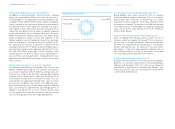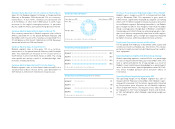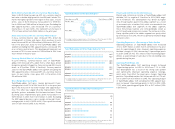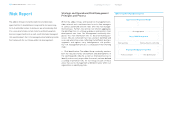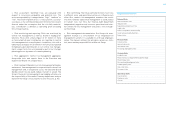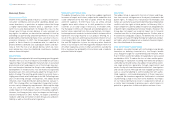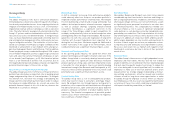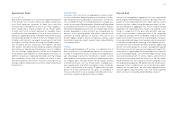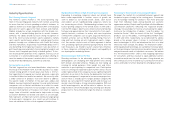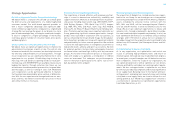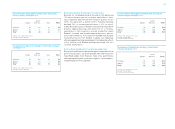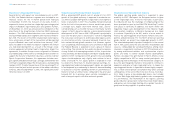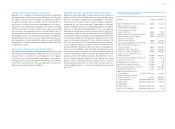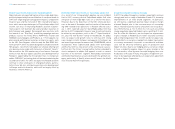Reebok 2006 Annual Report Download - page 104
Download and view the complete annual report
Please find page 104 of the 2006 Reebok annual report below. You can navigate through the pages in the report by either clicking on the pages listed below, or by using the keyword search tool below to find specific information within the annual report.Group Management Report ›
Strategic Risks
Portfolio Risks
The adidas Group faces risks due to contractual obligations
following business divestitures and with regard to the integra-
tion of newly acquired businesses. In our ongoing initiatives to
integrate the Reebok brand, we face a risk of overestimat-
ing potential revenue and cost synergies as well as execution
risks. The latter relate for example to the harmonization of the
Group’s IT systems and the standardization of functional busi-
ness processes across the different brands. To mitigate these
risks, we have implemented a dedicated controlling function
and an integration management office continuously oversee-
ing our integration activities. The realization of the first pro-
jected cost synergies in 2006 gives us higher confidence in the
likelihood of achievement of our medium-term synergy tar-
gets (see Subsequent Events and Outlook, p. 106). In addition,
formal employee surveys conducted throughout 2006 as part
of our Reebok integration activities suggest high satisfaction
rates and a positive cultural fit between employees at each
of our brands (see Employees, p. 65). We therefore believe
there is a low likelihood of portfolio risk occurrence. Due to
the magnitude of projected synergies, however, we regard the
potential financial impact of these risks as high.
Risks from Loss of Key Promotion Partnerships
The adidas Group faces risks from the loss of major promotion
partnerships which play an important role in building brand
image and generating sales of licensed product. To mitigate
the inherent risk, we follow the strategy of broadening the
Group’s portfolio of premium partnerships in order to reduce
the reliance on single affiliations. As a result, we assess the
potential financial impact of this risk to be low, whereas the
likelihood of occurrence is medium.
Brand Image Risks
A shift in consumer taste away from performance products
could adversely affect our Group as our product portfolio is
weighted towards performance-oriented styles. We mitigate
this risk by following a multi-brand strategy with brands that
address distinct performance-oriented consumer segments
as well as product offerings targeting lifestyle-oriented
consumers. Nonetheless, a significant restriction in the
usage of the Three Stripes symbol in sport competition, for
example, could potentially harm our brand recognition value
and negatively affect the image of brand adidas. We have miti-
gated this risk with the successful negotiation of long-term
solutions with the sport federations most important for us
during the last two years. We hence regard the likelihood of
further restrictions in the usage of the Three Stripes, which
could potentially have a significant financial impact, as low.
Research and Development Risks
In the sporting goods industry, the speed with which new
product technologies are brought to market is decisive. If the
adidas Group failed to constantly develop innovative prod-
ucts, we would risk a significant sales decline as innovative
products generate strong sales and more importantly create
a halo effect for other products. Due to our industry-leading
innovational strength (see Research and Development, p. 69),
we assess the occurrence probability of this risk, which could
potentially have a significant financial impact, as low.
Product Quality Risks
The adidas Group faces a risk of selling defective product,
which may result in injury to consumers and image impair-
ment. We mitigate this risk through rigorous testing prior to
production, close cooperation with manufacturers throughout
the fabrication process, open communication about defective
products and quick settlement of product liability claims if
necessary. The financial consequences of potential product
liability cases, whose likelihood of occurrence we regard as
low, could have a medium impact.
Own-Retail Risks
New adidas, Reebok and Rockport own-retail stores require
considerable up-front investment in furniture and fittings as
well as ongoing maintenance. In addition, own-retail activities
often require longer-term lease or rent commitments as well
as significantly more personnel in relation to net sales than
our wholesale business. This comparably less flexible cost
structure implies a risk in cases of significant unexpected
sales declines, as such declines cannot be immediately com-
pensated by cost reductions. The Group minimizes this risk by
only entering into lease contracts with a duration of less than
ten years. In addition, all shops must fulfill ambitious profit-
ability targets dependent on size, location and investment in
the store. If these targets are not met, we undertake restruc-
turing measures and eventually close unprofitable locations.
We assess own-retail risks as medium with regard to their
likelihood of occurrence, but low in terms of their potential
extent of loss.
Personnel Risks
The adidas Group’s future success is highly dependent on our
employees and their talents. We thus face the risk of being
unable to identify, recruit and retain the most talented people
that best meet the specific needs of our Group. To reduce the
risk of not being able to recruit qualified staff, to enable our
employees to make use of their full potential and to retain
key personnel, we strongly engage in developing a motivat-
ing working environment, attractive reward and incentive
schemes as well as long-term career opportunities to make
the adidas Group the employer of choice within our industry
(see Employees, p. 65). As a result, we regard the likelihood of
occurrence of these risks, which could have a medium finan-
cial impact should they materialize, as limited.
› Risk Report
100 ANNUAL REPORT 2006 › adidas Group ›




